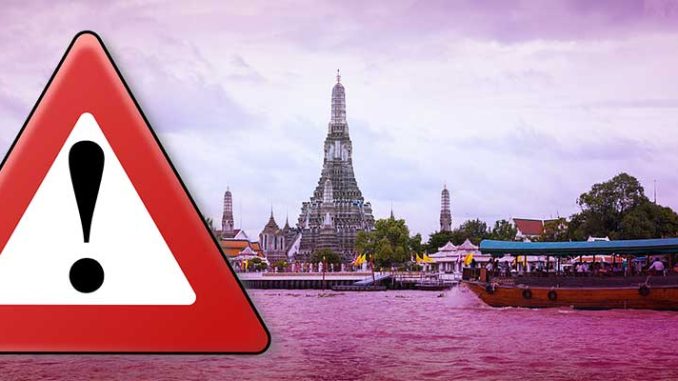
Sunisa Soomprasert and Nattaya Binuma are not relatives. In fact, they have never met and live 170 kilometres apart. Still, the two women share a lifeline of sorts, having been born and raised on the banks of the Chao Phya River. They also have one other thing in common: they know all too well the pain and anguish of having to share the river with factories.
At her house in Angthong province, Sunisa, 32, wakes up every morning with a fear of seeing the fish she raises floating dead in the river as has happened twice in the past two years. Nattaya, 30, on the other hand, rises from her bed to be greeted by riverborne garbage floating in front of her house in Samut Prakan.
Yet the complaints of Nattaya and Sunisa only reflect a small sample of the indignities the Chao Phya River is forced to suffer. For much of her 379 kilometres she is an open sewer for human, industrial and agricultural waste. Repeated exposure to her critical state in the past decade has made many of us understand that something needs to be done by state agencies and others to improve the situation.
But apparently the current effort to rescue the country’s main riverine artery is not enough. Every day at least 500 tonnes of organic pollutants (in the form of biochemical demand, or BOD) are discharged into the river, onefifth from industrial sources while the rest comes from domestic and agricultural sources. To realise how much this is, think of the combined load of 20 to 25 10wheel trucks.
Among the polluters are nine million household residents, operators of 5,853 square kilometres of agricultural areas and nearly 20,000 factories. And the figure could double to 1 million kilometres per day if including unidentified and unrecorded sources of pollution. As a result, the situation is getting worse. The most polluted stretch, which used to be between the river’s mouth in Samut Prakan and Klong Toei Port, has moved upstream to the Krungthep Bridge.

High bacteria level
The site is only 48km away from Pathum Thani’s Samlae district, where water from the river is diverted into Klong Prapa, the canal from which production of tap water for people in Bangkok and nearby provinces takes place.
Total coliform bacteria (TCB) at Klong Toei was found to be 1.6 million units (MPN per 100 millilitres) – the highest level ever recorded – in the latest test in December. The average level of TCB in the past decade was 200,000 units, while the acceptable level is between 4,000 and 20,000 units. Sunisa and Nattaya are among more than 100 Chao Phya residents who reported their complaints about water pollution to the Pollution Control Department (PCD) last year.
The quality of water in the Chao Phya river is crucial for Sunisa’s survival. She is a former factory worker who was laid off during the 1997 economic crisis. After receiving Bt200,000 compensation from her employer, she went back home to Angthong and invested all of the money in a river fishery under the guidance of the Charoen Pokphand Group, Thailand’s largest agrobusiness.
One morning a year later she woke up to find all of her fish floating dead. She later identified the culprit as an MSG factory next door that had discharged waste water into the river. She and her neighbours protested against the company to pressure it to fix a broken wastewater pipe. Still, the same thing happened again last summer, this time because of a nearby paper mill and a cotton factory. She lost the Bt60,000 she was expecting to earn from the sale of the fish because of the dirty water.
Nattaya’s predicament is even worse and more complicated as she lives next to an industrial zone in Samut Prakan. Her house is right at the mouth of a canal running from the Bang Poo Industrial estate to the Chao Phya River. Recently the Greenpeace environmental group undertook tests that found a high level of contamination in the soil sediment under the bed of the canal, including eight types of cancer-causing organochlorine substances and 10 types of heavy metal, which could affect her and her neighbours’ health. She and her neighbours complained about the problem to the local authorities, but there has been no official response to their worries.
The Pollution Control Department (PCD) last year produced a computer model projecting what it would be like if nothing were done to improve the situation. The average level of organic pollutant (BOD) would rise to more than three times the existing level. The dissolved oxygen level would drop to only 0.5 milligrams per litre, whereas the standard should not be lower than 2mg/l, otherwise it becomes impossible for fish to survive.
Of the three major sources of pollution, factories, domestic waste water and agriculture farms, drain water from communities is ranked by the PCD as the biggest polluter. The main indicators are the reduced level of dissolved oxygen in the water, an increase in organic pollutants (BOD) and a rapid rise of coliform bacteria. PCD statistics show that 90 per cent of the pollution originates in Bangkok, Samut Prakan, Nonthaburi and Pathum Thani.
In the agricultural sector, the intensive use of chemical fertilisers and pesticides is the major issue as the main central basin supports a huge commercial ricegrowing area. “Each rai of rice needs at least 50kg of chemical fertilisers, and we do three crops a year,” said Somsak Hiran, a farmer in Chai Nat. The chemical used for killing a major pest like the sherry snail is a prominent pollutant in the upper and middle reaches. Raising fish in the river, as in Sunisa’s case, itself is a new potential source of pollution for the river due to the high use of chemical fish food and antibiotics.
Industrial operators do not contribute much in the way of organic waste but are the source of an even worse problem, heavymetal contamination. However, the PCD said the contamination level was still within its safety standards. Nonetheless, Wicharn Simachaya of the PCD admitted that the standards themselves might be a problem. He said the current ones were too broad and did not consider the river’s carrying capacity for a particular type of pollution. An adjustment of the standards is on the way, he said.
Some marine scientists have said toxic substances and heavy metals are accumulating in soil and plankton on the bed of the river mouth and inner Gulf of Thailand. This has caused toxic contamination in aquaspecies which finally come back to us in the food chain, but no study has explicitly shown this relationship.
Why does the problem remain unsolved? Many people cite the lack of cooperation among the more than 30 agencies under eight ministries which have roles in supervising the river. The PCD is pushing hard to seek better cooperation by gathering the agencies under one centre. It has proposed including some agencies from the Forestry Department, Fishery Department and the Industry Ministry. The agency is also looking at the possibility of privatising some agencies and collecting fees for wastewater treatment. “But we haven’t received any clear sign from government about our proposal,” PCD senior official Yuwaree Inna said.
Sunisa has decided she will not wait. She and her neighbours who raise fish have set up a group to get more bargaining power. For example, they once pressured some factories to cut back on the amount of waste water they discharged on dry summer days.
But Nattaya seems to be less fortunate. Her life in the big city does not provide her with many chances of setting up a grouping with other similarly afflicted people. Thus she and her family have no choice but to live with the pollution.
Kamol Sukin and Sirinart Sirisunthorn
This article appeared in Bangkok’s The Nation, 9 February 2002.
Kyoto Review of Southeast Asia. Issue 2 (October 2002). Disaster and Rehabilitation

